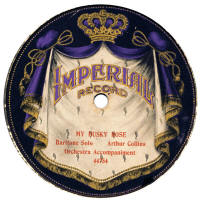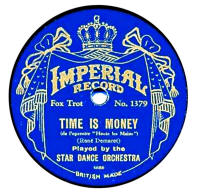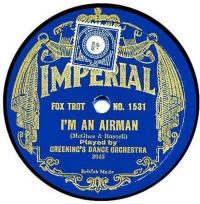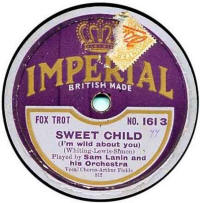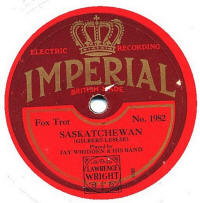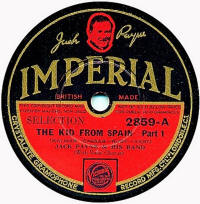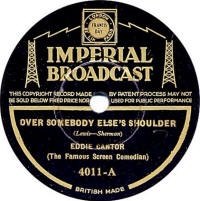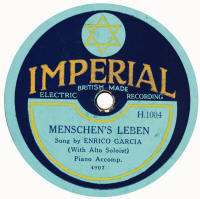The first Imperial records were manufactured in the
USA, by Leeds & Catlin of New York, and were imported into Britain by
Gilbert Kimpton & Co. from April
1906 to 1909. These were single-faced records and are very rare these days.
They were initially priced at 2/6. later reduced to 2/-. Leeds &
Catlin stopped manufacturing them by 1909 and in 1911, the trade mark was
acquired by the Sound Recording Company in England.
Thanks to Norman Field for the
label scan.
A 1913 issue of Talking Machine News announced the
new Imperial Label (see second image, right). Until last week (January 2025)
none of these had been seen by British researchers. However, thanks to
American discographer Allan Sutton, who has sent this image, we now have
proof that the records actually existed, as you can see! The record, despite
being found in the US has a British copyright stamp, implying it was sold in
the UK, so there is still a mystery to solve as to how and where they were
sold. The label does nopt appear in the British Trade magazines of the
period, so maybe they were exported?
The 1913 advert showed three new
labels being launched: Popular, Imperial and Stavophone, and the last named
has still to be found!
In Autumn 1922, the Sound Recording Company, who had
been responsible for records issued on the Grammavox and Popular labels,
launched it's new Imperial label to replace the existing "Popular" label (by
then, rather strangely titled "Ye Popular").
The records cost 2/- each, and the catalogue numbers started
(rather oddly) at 1047 using
the first blue label style seen on the left here, which you can see owes the
basic design to the original American label. Unusually, the numbering went
forward for new recordings, but backward (eventually to about 820) for old
recordings taken from the Grammavox, Popular & Bulldog vaults. They reached
2953 by 1934 when the label was dropped in favour of the new Rex label. The
English matrix numbers followed on from those used on "Popular" and reached
about 6550 by the label's demise in 1934.
In Autumn 1923, an arrangement with America's Banner record company (aka Regal Record Co, New York) meant their masters started appearing on Imperial in England. They were given control numbers on the labels, starting in the low 100's, though often the original matrix number was visible in the run-out area near the label.
In September 1925, the Crystalate Manufacturing Company
bought the Sound Recording Company. Crystalate, based in
Tonbridge, England, had been involved with the manufacture of Disc records
from very early on, when they assisted Nicole Freres in setting up production of their
Nicole Records back in 1903.
In 1927, Crystalate acquired a part
interest in the American Regal Company, who's main label in the US was
"Banner" and, in fact is often referred to as the company name! Subsequently,
I believe Crystalate took over the American company.
Regal had started
electrical recording, albeit initially of a rather crude type, in late 1925, and some
early examples are found on the later blue label, right, but Imperial
introduced the attractive purple label soon after. Crystalate themselves
didn't start their own electrical recordings until 1927, long after all
other companies had switched to electrical. This is not as odd as it would
seem. As a cheap label, most of the purchasers would probably still be using
older acoustic gramophones to play their records. While
these would reproduce acoustic records very well, electrical records could
sound distorted.
When the Crown Record Company (in the
USA) started in 1931 Imperial started using their masters and Banner masters
appeared less often. Later Imperials use masters from ARC/Brunswick (which
included Banner). When bandleader Jack Payne signed to the label in 1932, Imperial made
the unprecedented step (in England) of including Jack's likeness on the
label and almost all the last issues in 1933 & 1934 are by Payne, after
the Rex label had superceded Imperial. Recording
quality gradually improved and was quite favourable comparable with more
expensive makes by 1933.
The majority of Imperials are 10". They
cost 2/- from their launch in October 1922 until October 1927 when the price
was reduced to 1/6. In March 1931 it was reduced still further to 1/3. Some
free publicity discs were issued, from 1922 to 1932, which were 3½"
diameter. For more information about these,
click here.
12" records, usually of a light classical nature were originally issued on
the Crystalate label, but later the familiar red Imperial label was used,
and a Z-serial catalogue number and costing 2/-. Imperial records were aimed
at the popular market, but some 10" light classical sides were issued, and
these had a dark red background rather then the purple or black. The odd
issue of popular or Dance Band music accidentally appeared on this style of
label, and an example can be seen, right.
Dance Bands on Imperial
Most of the early dance band recordings
on Imperial are American, but there are a few British recordings by
Derrick's Band. Jack Derrick was the saxophonist-leader of this small band
which is thought to be part of Jack Hylton's organisation. In 1924, Stan
Greening was appointed at Musical Director and most subsequent British sides
are by a studio band under his direction, using the usual musicians
associated with him.
By the start of the "Purple" era, Teddy Brown's
band was making sides for the label, generally featuring his xylophone
playing (labelled as "xylophone effects").
Ace
arranger and bandleader, Ronnie Munro, made a few good acoustic sides
labelled as "Buddy Rose and his Orchestra", and Syd Roy's Lyricals also made
some good titles, some being the earliest electrical ones in 1927.
With
the advent of electrical recording, Stan Greening's name ceased to appear on
the labels, though he was involved with Crystalate until at least 1932. Jay
Whidden's Carlton Hotel Band also recorded for Imperial from 1928 to 1930
and are worth picking up for the arrangements of Peter Yorke and Lew Stone
and many "hot" solos on trumpet by Max Goldberg.
In late summer 1930, Jay Wilbur joined
the company as musical director, from the failed Dominion Record Company.
Wilbur was also key in improving the recording quality, with the
help of new engineers
Arthur Haddy & Kenneth Wilkinson.
When Decca bought the company in 1937, the two
engineers continued on to fame with their work on sound expansion becoming
Decca's "ffrr" and "ffss" systems. Jay Wilbur directed many sides until 1933 when he
launched Rex records, leaving Jack Payne in sole "charge" of Imperial for a
further year. At the time Wilbur joined, the label colour changed to black
with the red surround and title area.
Following Crystalate's takeover of
Vocalion in 1932, they formed a hybrid label called Imperial Broadcast (see
picture). This seems to have been short-lived and the repertoire was usually
classical, though the occasional popular item turns up as you can see.
See my
Broadcast page
for a full listing of this label.
For American material, Imperial
generally relied on Banner (aka Regal Record Co, New York, with whom
Crystalate merged in about 1929) to provide the majority of their dance
records, with bands such as Sam Lanin, Adrian Schubert, Fred Rich, Nathan
Glantz, Vincent Lopez and Harry Reser. A few sides by Fletcher Henderson's
orchestra, with young cornettist Louis Armstrong, were issued too. The
American electrical recording were rather boxy to start with but soon
improved, though they can be rather inconsistent, varying between a rather
thin, slightly distorted sound to the recordings from Cameo records with
their rather boomy bass response. (Banner, Cameo and Perfect in America
seemed to swap recordings at random!).
Some of the American masters were
issued under pseudonyms, though this was generally to hide Adrian Schubert's
studio recordings; The usual name was "Imperial Dance Orchestra" (I bet it
took a bit of hard thinking to come up with that one!), "Hollywood Dance
Orchestra", and "Majestic Dance Orchestra". The main problem, though, seems
to be mis-labellings, i.e. sides by one band issued as by another.
Surfaces on Imperial records were
generally quite smooth, often better than most more expensive makes, or at
least, they have remained smooth, whereas some, particularly Gramophone
Company records (HMV & Zonophone) have deteriorated in the intervening
years.
In the mid-1920s, Crystalate manufactured a 7"
record, Imperial Junior, for export to Australia, with also a special series
for Holland. All masters were
UK-recorded and all were acoustic. These will be found on
their own page.
A number of 3½" Imperials were made for advertising
purposes. Again, these will be found on
their own page.
A full listing and history of Imperial records by
Frank Andrews and Bill Dean-Myatt is available from the
CLPGS
in their Reference Series booklet.
